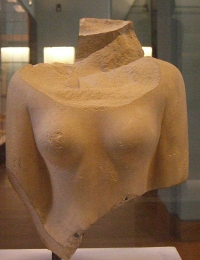
Mortuary temples were located on the north side of the pyramid during the third dynasty but by the fourth dynasty they were placed to the east of the pyramid. It is possible that the large open space to the north of the pyramid of Djedefre at Abu Rawash was the intended site of Djedefre’s Mortuary temple, but so far no evidence of a temple at this spot has been found. While this would be contrary to the practice in the fourth dynasty, the substructure of Djedefre’s pyramid suggests that he chose to follow the traditions of the third dynasty instead so it may not be that surprising.
The remains of what may be a mortuary temple have been discovered to the east of the pyramid by the inner wall. Votive pottery found here confirms that there was an active mortuary cult for Djedefre at the site for some time. This temple differs significantly from other Old Kingdom examples in that the causeway does not connect with this temple and it has been suggested that this was a building of alternate use which was hastily converted into a mortuary temple on the death of the pharaoh.

Thick stone walls have been finished with mudbrick. A number of chambers and store rooms surround an open courtyard. There is a paved area here but it is possible that this was actually the foundation platform and the actual paving has long since been removed. What was once described as a “cult niche” in the east face of the pyramid may just be a defect in the casing.
To the north-east of this court there was a row of column fragments some of which were inscribed with Djedefre’s name.
A limestone female sphinx (covered in plaster from the Roman Period) that may be the first example of a sphinx was found here along with statue bases recording the names of five of Djedefre’s children.
- Baka – “king’s eldest son, god’s servant of Djedefre”
- Hornit – “king’s eldest son of his body, iri-pat, eldest king’s son”
- Setka – “iri-pat, head of secrets in the royal bedroom, king’s eldest son of his body, sole companion of his father, lector-priest of his father, commander of the palace”
- NeferHetepes – “king’s daughter of his body, endowed by her father, god’s servant of Djedefre, god’s servant of Hathor mistress of the sycamore”
- Hetepheres – “king’s daughter of his body”
It was once thought that these statues had been deliberately destroyed shortly after the death of Djedefre (adding fuel to rumours of a family feud) but it is now agreed that this damage was done much later during the Roman period and by Christians following the construction of a Coptic monastery in the area.
Bibliography
- Kathryn Bard (2008) An introduction to the Archaeology of Ancient Egypt
- Mark Lehner (1997) The Complete Pyramids
- Miroslav Verner (2009) The Pyramids
Copyright J Hill 2010